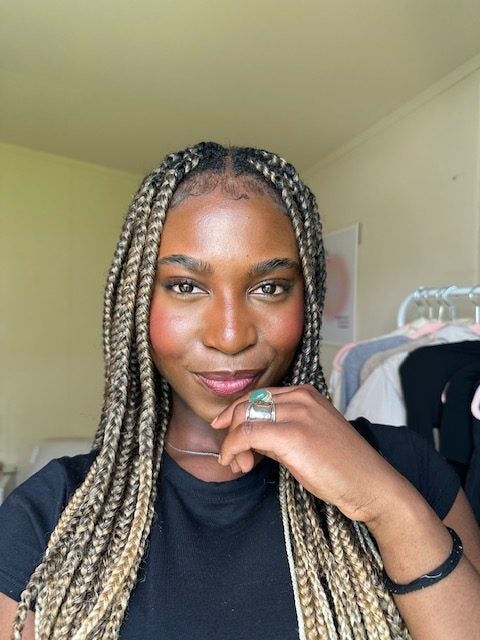Oré Otun still vividly recalls the moment she learned about Fenty Beauty’s foundation release in the fall of 2017. “I remember begging the guy I was dating to take me to get it because I didn’t have a car. I was so hype,” she says. The Houston-based beauty content creator’s unbridled excitement stemmed from the lack of representation for dark-skinned women and often feeling categorically ignored by major beauty brands.
Thankfully, Rihanna kept Otun, and others like her, in mind when crafting the Pro Filt’r Soft Matte Longwear Foundation. Although it was not the first makeup brand to release deep shades in general, Fenty did so during their first launch as a new brand– instead of doing it over time. And since its inception our favorite bad gal has been vocal about the importance of creating makeup for everyone. The brand’s industry-disrupting hero product launched with over 40 wide-ranging shades, making it one of the most inclusive first releases in the beauty space. This certainly marked a change in tide for many dark-skinned Black women.
Similarly, “I remember being in shock,” says beauty content creator Beyonce Janvier. She adds that prior to the Fenty drop, she never put much stock in finding a foundation that matched her skin. She would typically have to buy multiple shades to mix together in hopes of concocting an accurate shade. “I never knew I even had an undertone or really cared about finding my perfect shade until [Fenty Beauty],” says Janvier.

No longer having to play cosmetic chemist is an unchallengeable win. The release of the Fenty foundation was a blessing not only to complexions at large but wallets everywhere. New York-based content creator Christina Abiola says that before Fenty, the only brands that carried her shade were luxury beauty houses that boasted pretty hefty price tags. Comparatively, Fenty’s foundations range from $22-$40.
And with nearly 60 total shades, expansive coverage variations and countless awards in innovation, Fenty Beauty has undeniably changed not only the way we shop but how other makeup brands launch, release, and revamp their own products. This reality is quaintly referred to as “The Fenty Effect,” by industry insiders. These days, big-name players– such as L’Oréal, Maybelline and CoverGirl– all carry at least 40 shades.
But even still, these days, “some brands will come out with foundations, and then say, ‘Oh, we’re going to come up with the darker shades later,’” says Otun. This rhetoric can be applied to any number of brands. Youthforia, for example, faced a similar discrepancy with the release of their Date Night Skin Tint. The supposedly “safe to sleep in” foundation faced major backlash on TikTok for their lack of shade range and what some are describing as false advertising regarding their imaging online.
The CEO, Fiona Co Chan, responded in a TikTok video stating that the initial release was just a “proof of concept,” and they had deeper skin tones in the works. “I appreciate the gesture of the shade extensions and stuff, but it still hurts to be an afterthought,” says beauty and lifestyle content creator Jasmine Adetunji. Even more recently, they finally launched their deeper shade options but unfortunately have faced backlash again due to the darkest shade being compared to black face paint.

This issue extends beyond the realm of content creation as well, thanks to the role beauty brands play in setting societal standards, says Abiola. “A lot of us grow up wanting to feel beautiful. When brands cannot even include us, it’s like we’re not even a part of the standard,” says Abiola. “They’re essentially saying we are not even a part of the beauty spectrum, which is very hurtful,” says Abiola. Siphoning such a large portion of your consumer base is ironic as, according to a 2022 MBS Intelligence study, Black consumers spend an average of $1.2 trillion on beauty products each year.
Even in the makeup PR boxes they receive– an opportunity for brands to tap into these underserved audiences– many creators say they are still receiving inaccurate shade matches. Some have even noticed patterns of what they describe as purposeful exclusion from certain gifting opportunities. “A lot of brands send me other products…but not their foundations,” says Abiola. “I think we know why.”
Other creators say that while they receive pretty decent shade matches in their PR boxes, it is often the brand’s darkest foundation. “And I’m not even the darkest person out there. So that’s really scary to think about,” says Adetunji.

It’s also worth mentioning that, for newer or smaller creators, it can be daunting to challenge these beloved companies, especially when their backing can be vital to career longevity. “It got to a point where I was really quiet about certain things once I started monetizing my content,” says Abiola. As a dark-skinned creator, it is difficult enough without the added fear of jeopardizing future brand deals.
Having to worry about whether or not a brand will have your shade also takes away from the fun of what should be an exciting time in makeup and beauty innovation. “As somebody who loves makeup and loves trying out new products, it’s heartbreaking to not be able to participate in the excitement that other people get to participate in because your shade is not considered,” says Adetunji.
So, where do we go from here? For many content creators, the answer is quite simple. “We should go where we’re loved,” says Otun. “There are brands who include us and when we sit and we talk about the brands that don’t it does a disservice for our community,” explains Otun.

Conversely, some creators say speaking out is the only way to hold these brands accountable. In either regard, one thing remains consistent amongst content creators and consumers alike: the post-backlash apology videos and public statements of promises to do better are no longer going to cut it.
TLDR: It’s time for brands to get off the apps and in the lab!







